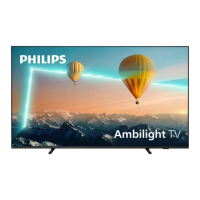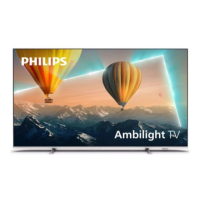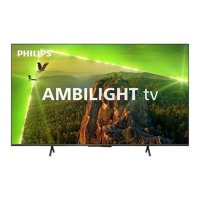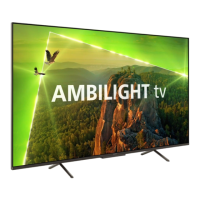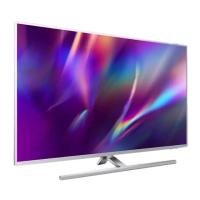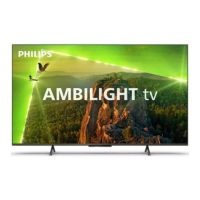Do you have a question about the Philips 43PUS8079 and is the answer not in the manual?
Select SOURCES to view and change to available sources in this TV.
Discover movies and shows from services and popular apps via tabs like Home, Channels, Apps and Search.
Your favourite Apps are placed on the first row, ordered by business agreements.
This row contains Recommended, Subscriptions or Trending YouTube and Netflix videos.
Access All Settings, Frequent settings, and Quick menu via icons on the Home screen.
Select TV Guide to open the TV Guide of your installed TV channels.
Find TV model number and serial number; register your TV for support and benefits.
Access TV information, How-to guides, diagnose, update software, and user manual.
Run diagnostic tests to check TV condition, picture, sound, network, and remote control.
Contact the Consumer Care hotline for support and repair services.
Overview of remote buttons, including hidden keys, and their functions for TV operation.
Location and function of the TV's IR sensor for remote control commands.
Instructions for replacing remote control batteries and cleaning the remote.
Important safety guidelines to read before using the TV.
Tips on optimal TV placement for viewing, Ambilight, and wall mounting specifications.
Steps to connect the power cable and turn the TV on or put it into standby mode.
Guidelines for connecting devices with high-quality cables for optimal picture and sound.
Instructions for connecting an antenna or distribution system to the TV's antenna socket.
How to attach the satellite F-type connector to the TV's satellite connection.
HDMI connection details for best picture/sound quality, including copy protection (HDCP).
Information regarding connecting audio devices to the TV.
Using Screen Mirroring to view mobile content on TV, and how to stop or block devices.
Connecting headphones and adjusting their volume.
Information on using CAM with Smart Card (CI+) for conditional access.
Connecting a computer to the TV to use it as a PC monitor via HDMI.
Open the sources menu to view and switch between connected devices.
Procedure to rename connected input sources via the TV's settings menu.
How to watch TV channels, switch between them, and use the channel list.
Manual search for channels, update channels, quick/advanced reinstallation, and frequency settings.
Opening, options, renaming, and filtering the channel list.
Creating, editing, removing, and reordering favourite channel lists.
Using Teletext for subtitles, information, and options like freeze page and dual screen.
How to watch free streaming channels and manage advertising privacy settings.
Information on viewing current and scheduled TV programmes via the TV guide.
How to open, tune to programmes, view details, update, and search by genre in the TV Guide.
Overview of Freeview Play features: missed programmes, on-demand, channels, and services.
Steps to open, search, and navigate Freeview Play players and programmes.
How to use the TV guide with Freeview Play, including changing days and accessibility preferences.
Viewing photos, playing music, and videos from a connected USB flash or hard drive.
Streaming media from a computer or NAS over the home network.
Viewing photos, slideshows, and adjusting photo display options.
Playing video files, controlling playback, and adjusting subtitle and audio settings.
Playing music files and adjusting music playback options.
Accessing quick settings and common TV functions via the Quick Menu.
Navigating through Picture, Sound, and other advanced settings menus.
Adjusting energy-saving settings like screen off and TV switch-off timers.
How to launch and close the gaming control bar for enhanced gaming experience.
Information displayed in the gaming dashboard: input lag, frame rate, resolution, content type.
Adjusting gaming-related settings like crosshair, shadow control, and audio output.
Initial setup for Smart TV, including connection configuration and agreeing to terms.
Browsing and installing apps from the Apps tab, categorized by content type.
Overview of Amazon Alexa voice control, requirements, and availability.
Steps to set up Alexa client service on the TV and link your Amazon account.
Examples of voice commands for changing channels, volume, and controlling TV functions.
Methods to search for and update TV software via Internet or USB.
How to view the current TV software version.
Enabling or disabling automatic software updates for the TV.
Displaying a list of successfully installed software versions.
Information on the TV's energy efficiency class and power consumption.
List of EPREL registration numbers for different TV models.
Disposal instructions for old products and batteries, and recycling information.
Power requirements and ambient temperature specifications for the TV.
Details on aerial input, tuner bands, digital/analogue video/audio playback, and satellite input.
Diagonal screen sizes and display resolutions supported by the TV.
Supported computer/video and video-only resolutions and refresh rates.
Sound specifications including output power, Dolby features, and AI sound.
Supported multimedia connections and file systems.
Overview of TV side and bottom ports, including HDMI, USB, Antenna, and Network.
General tips for finding solutions, using keywords, and accessing support resources.
Troubleshooting steps for when the TV does not switch on or makes creaking sounds.
Troubleshooting issues with the remote control not responding or having empty batteries.
Solutions for finding no digital channels, disappeared channels, or poor reception.
Troubleshooting satellite reception, finding satellites, and channel list issues.
Resolving issues with no picture, distorted picture, sound but no picture, or poor picture quality.
Troubleshooting no sound, poor sound quality, or distorted sound from connected devices.
Addressing issues with HDMI device recognition, picture distortion, and UHD signal quality.
Troubleshooting for photos, videos, music not showing, or choppy playback from USB devices.
Resolving issues with Wi-Fi network, internet connection, or slow connection speeds.
Steps to change the TV menu language back to the correct language.
Important safety instructions regarding electric shock, fire, injury, and damage to the TV.
Guidelines for cleaning the TV screen and avoiding damage from stationary images.
HDMI trademark information.
Information about HEVC patents.
DTS:X patent and trademark information.
Dolby ATMOS trademark and licensing information.
Wi-Fi CERTIFIED trademark information.
Acknowledgement of other registered and unregistered trademarks.
Information on the availability of source code for copyrighted open source software packages.
Description of licenses for TP Vision Europe B.V. TV software, including GPL and LGPL.
Select SOURCES to view and change to available sources in this TV.
Discover movies and shows from services and popular apps via tabs like Home, Channels, Apps and Search.
Your favourite Apps are placed on the first row, ordered by business agreements.
This row contains Recommended, Subscriptions or Trending YouTube and Netflix videos.
Access All Settings, Frequent settings, and Quick menu via icons on the Home screen.
Select TV Guide to open the TV Guide of your installed TV channels.
Find TV model number and serial number; register your TV for support and benefits.
Access TV information, How-to guides, diagnose, update software, and user manual.
Run diagnostic tests to check TV condition, picture, sound, network, and remote control.
Contact the Consumer Care hotline for support and repair services.
Overview of remote buttons, including hidden keys, and their functions for TV operation.
Location and function of the TV's IR sensor for remote control commands.
Instructions for replacing remote control batteries and cleaning the remote.
Important safety guidelines to read before using the TV.
Tips on optimal TV placement for viewing, Ambilight, and wall mounting specifications.
Steps to connect the power cable and turn the TV on or put it into standby mode.
Guidelines for connecting devices with high-quality cables for optimal picture and sound.
Instructions for connecting an antenna or distribution system to the TV's antenna socket.
How to attach the satellite F-type connector to the TV's satellite connection.
HDMI connection details for best picture/sound quality, including copy protection (HDCP).
Information regarding connecting audio devices to the TV.
Using Screen Mirroring to view mobile content on TV, and how to stop or block devices.
Connecting headphones and adjusting their volume.
Information on using CAM with Smart Card (CI+) for conditional access.
Connecting a computer to the TV to use it as a PC monitor via HDMI.
Open the sources menu to view and switch between connected devices.
Procedure to rename connected input sources via the TV's settings menu.
How to watch TV channels, switch between them, and use the channel list.
Manual search for channels, update channels, quick/advanced reinstallation, and frequency settings.
Opening, options, renaming, and filtering the channel list.
Creating, editing, removing, and reordering favourite channel lists.
Using Teletext for subtitles, information, and options like freeze page and dual screen.
How to watch free streaming channels and manage advertising privacy settings.
Information on viewing current and scheduled TV programmes via the TV guide.
How to open, tune to programmes, view details, update, and search by genre in the TV Guide.
Overview of Freeview Play features: missed programmes, on-demand, channels, and services.
Steps to open, search, and navigate Freeview Play players and programmes.
How to use the TV guide with Freeview Play, including changing days and accessibility preferences.
Viewing photos, playing music, and videos from a connected USB flash or hard drive.
Streaming media from a computer or NAS over the home network.
Viewing photos, slideshows, and adjusting photo display options.
Playing video files, controlling playback, and adjusting subtitle and audio settings.
Playing music files and adjusting music playback options.
Accessing quick settings and common TV functions via the Quick Menu.
Navigating through Picture, Sound, and other advanced settings menus.
Adjusting energy-saving settings like screen off and TV switch-off timers.
How to launch and close the gaming control bar for enhanced gaming experience.
Information displayed in the gaming dashboard: input lag, frame rate, resolution, content type.
Adjusting gaming-related settings like crosshair, shadow control, and audio output.
Initial setup for Smart TV, including connection configuration and agreeing to terms.
Browsing and installing apps from the Apps tab, categorized by content type.
Overview of Amazon Alexa voice control, requirements, and availability.
Steps to set up Alexa client service on the TV and link your Amazon account.
Examples of voice commands for changing channels, volume, and controlling TV functions.
Methods to search for and update TV software via Internet or USB.
How to view the current TV software version.
Enabling or disabling automatic software updates for the TV.
Displaying a list of successfully installed software versions.
Information on the TV's energy efficiency class and power consumption.
List of EPREL registration numbers for different TV models.
Disposal instructions for old products and batteries, and recycling information.
Power requirements and ambient temperature specifications for the TV.
Details on aerial input, tuner bands, digital/analogue video/audio playback, and satellite input.
Diagonal screen sizes and display resolutions supported by the TV.
Supported computer/video and video-only resolutions and refresh rates.
Sound specifications including output power, Dolby features, and AI sound.
Supported multimedia connections and file systems.
Overview of TV side and bottom ports, including HDMI, USB, Antenna, and Network.
General tips for finding solutions, using keywords, and accessing support resources.
Troubleshooting steps for when the TV does not switch on or makes creaking sounds.
Troubleshooting issues with the remote control not responding or having empty batteries.
Solutions for finding no digital channels, disappeared channels, or poor reception.
Troubleshooting satellite reception, finding satellites, and channel list issues.
Resolving issues with no picture, distorted picture, sound but no picture, or poor picture quality.
Troubleshooting no sound, poor sound quality, or distorted sound from connected devices.
Addressing issues with HDMI device recognition, picture distortion, and UHD signal quality.
Troubleshooting for photos, videos, music not showing, or choppy playback from USB devices.
Resolving issues with Wi-Fi network, internet connection, or slow connection speeds.
Steps to change the TV menu language back to the correct language.
Important safety instructions regarding electric shock, fire, injury, and damage to the TV.
Guidelines for cleaning the TV screen and avoiding damage from stationary images.
HDMI trademark information.
Information about HEVC patents.
DTS:X patent and trademark information.
Dolby ATMOS trademark and licensing information.
Wi-Fi CERTIFIED trademark information.
Acknowledgement of other registered and unregistered trademarks.
Information on the availability of source code for copyrighted open source software packages.
Description of licenses for TP Vision Europe B.V. TV software, including GPL and LGPL.
| Screen Size | 43 inches |
|---|---|
| Resolution | 4K UHD (3840 x 2160) |
| Panel Type | LED |
| Smart TV | Yes |
| Operating System | Android TV |
| Ambilight | Yes |
| HDMI Ports | 4 |
| USB Ports | 2 |
| Refresh Rate | 60 Hz |
| Audio Output | 20 W |
| Wi-Fi | Yes |
| Bluetooth | Yes |
| HDR Support | HLG |
